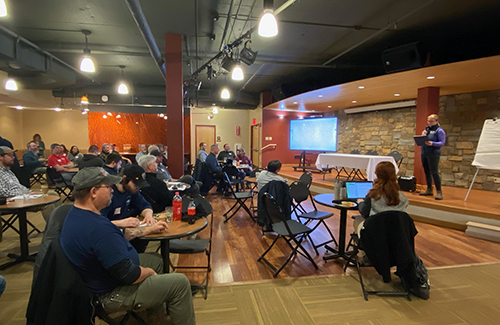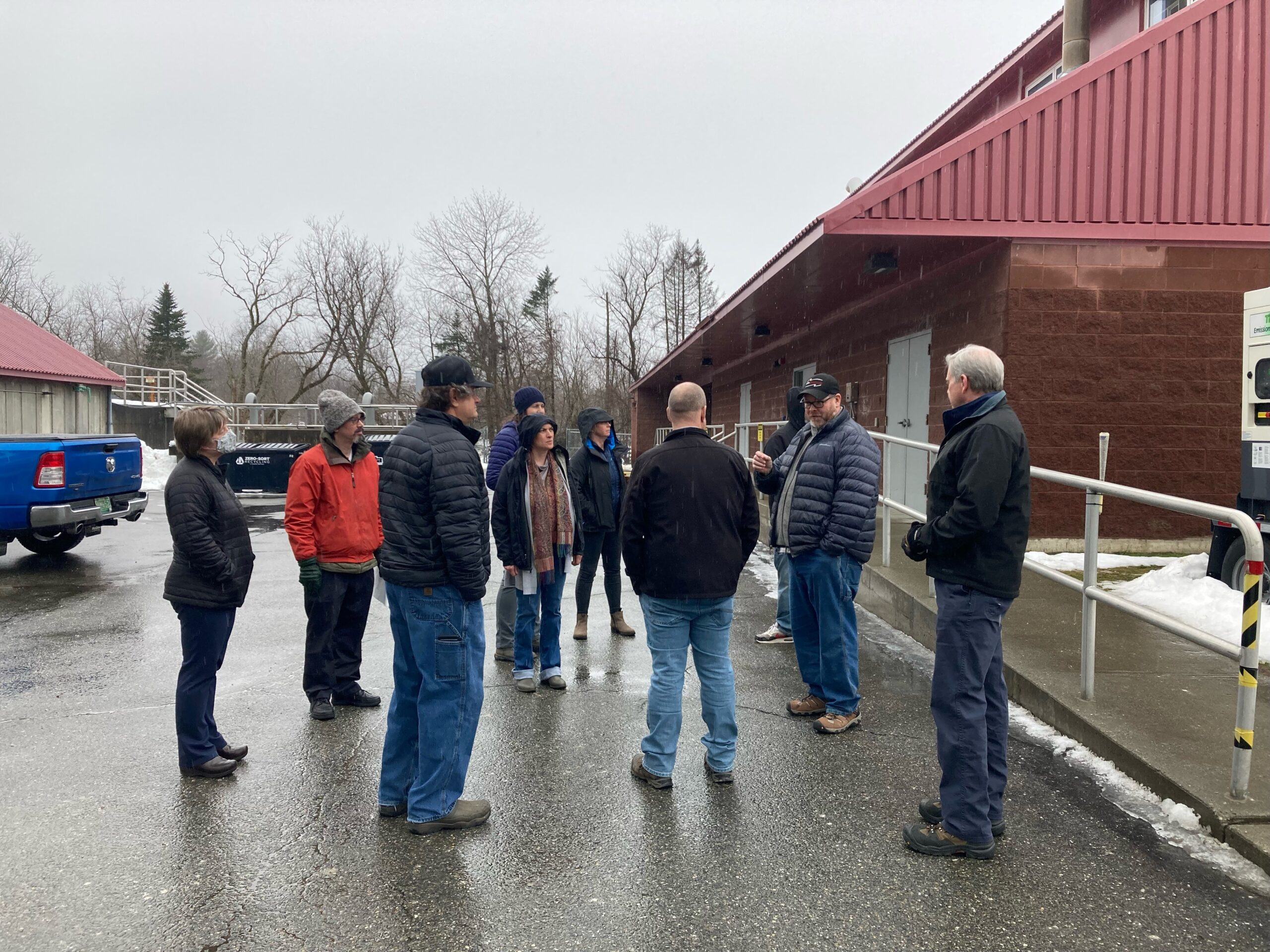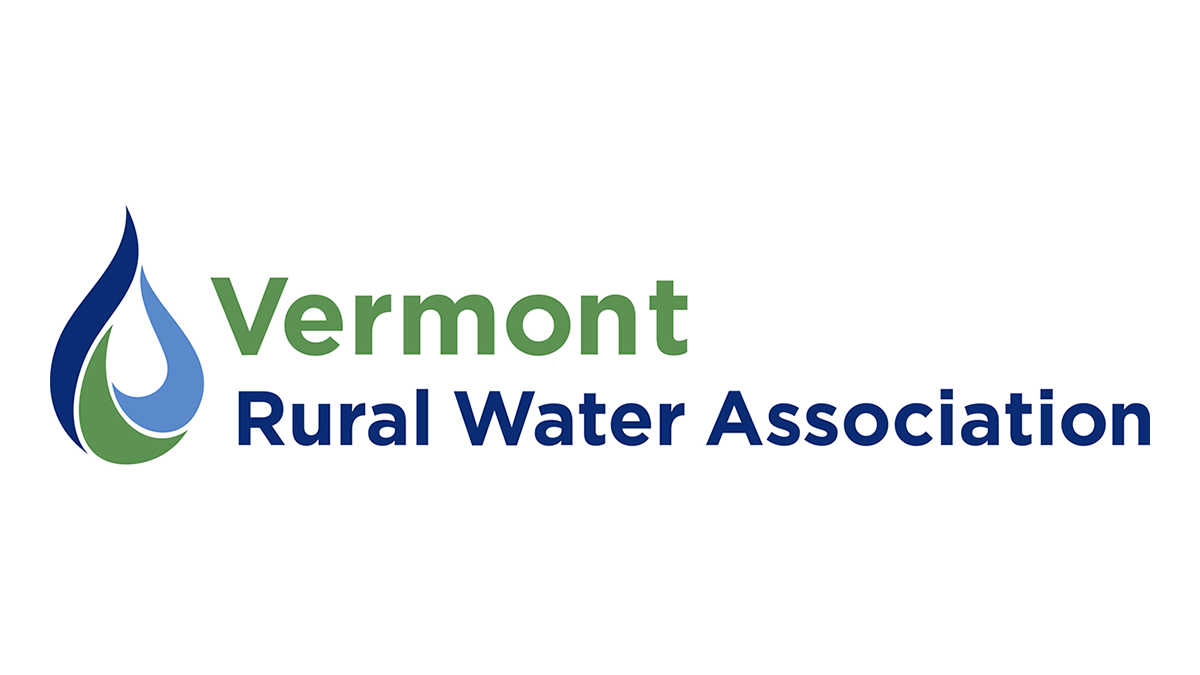by Katherine Boyk
This article was published in the spring 2024 issue of our newsletter.
In January, a group of water and wastewater operators, Vermont Rural Water staff, DEC employees, and partner organizations gathered at Vermont State University in Johnson to reflect on last summer’s devastating flooding. Everyone in the room had been involved in the flood response, whether their system itself was impacted, they helped out at a flooded facility, or they provided assistance from the office. It was a chance to share stories and lessons learned so we can all be better prepared for the next disaster.
Though all the impacted water and wastewater facilities are back online and operating, several of the hardest hit systems are still relying on temporary fixes while waiting on permanent repairs or replacement. And in the meantime, another big storm in December caused many of the same facilities to flood again.
Below are just a few of the stories and takeaways that struck me. I hope you will find these interesting and useful.

Over 40 people attended a discussion about flood response at Vermont State
University – Johnson in January.
Stories Shared
Preparation – Steve Cote and Brad Snow from Richmond Water Resources shared how they were able to continue providing drinking water even when their main well was completely submerged by floodwaters. The well is located in the floodplain of the Winooski River and floods frequently. They have a storage reservoir at a higher elevation that is large enough to hold ten days’ worth of water. Before the flooding in July, and again in December, they filled the reservoir and shut off the well pump in preparation. When the floodwaters receded—which took six days in July—they could tell the water had been above the well head. The well house was full of sand and silt and needed to be sanitized, but it survived the ordeal. The town was on a Boil Water Notice for several days but residents were never without water.
Inflow – Matt Jones with the Waterbury wastewater treatment facility talked about how he discovered a major source of inflow during flood events. There is a park along the Winooski River with bathrooms by the ball fields. In July, the floodwaters were above the height of the sinks and toilets, and Matt calculated that floodwaters going down the drains were adding at least a million gallons per day to the wastewater facility’s inflow. Since Waterbury’s lagoons were close to overflowing, which would have been catastrophic for the facility, reducing inflow during floods is critical. Matt hopes to install valves in the bathrooms that can be shut off in advance of future floods to prevent this problem.
Water Quality – Jeffry Bean, a water operator at an NTNC industrial park in Georgia, had a somewhat different experience than many. Rather than being impacted by flood damage, Jeff’s concern was water quality at the source and the ability to continue to treat the raw water adequately. The water source is Lake Arrowhead, which is fed by the Lamoille River, and during the flooding the water was incredibly turbid, causing very short filter runs due to excessive flushes and backwashes. Jeff was also keeping an eye out for contaminants like fuel oil from flooded communities upstream. Plans were made to haul potable water from another water system if a shutdown was required. Fortunately, the system was able to continue operations uninterrupted. While an NTNC being without water may not seem as severe as a community without water, it would have adversely affected the businesses and 540 workers in the industrial park. Jeff said “the flood was a catalyst of organizational changes,” which included addressing staffing and operational needs during an event of this nature.
Sewer Inspections – Michelle Kolb with the Vermont Wastewater Management Program shared many lessons learned. One that was new to me was doing post-flood collection systems inspections using a remote camera to view the insides of sewer pipes. The state helped facilitate these in ten communities, and found sewer pipes filled with rocks, silt, and other flood debris; pipes that were crushed or fractured; and pipes with holes or broken seals that were causing groundwater infiltration. Some of the damage found may have been pre-existing due to aging infrastructure, but was worsened by the flooding. This sort of damage is less apparent because it is buried underground, so these post-flood inspections helped many communities find and repair issues before they caused major problems.
Bacterial Hits – Tim Russo and Brad Roy from Vermont Rural Water talked about how some water systems that weren’t impacted during the initial flooding experienced issues weeks or months later. They’re seeing more source wells than usual test positive for coliform or other bacteria. Tim and Brad have performed camera inspections on many of these wells. They often find that the water table is much higher than average, which causes infiltration in wells and introduces bacteria to the water supply.

A tour of the Johnson wastewater treatment facility.
Johnson WWTF – After the meeting at VSU, Dan Copp offered a tour of the Johnson wastewater treatment facility. He showed us around the main building, which is elevated and has flood gates. The July flooding was the first time the flood gates were breached since they were installed in 1995. They were able to get all of their treatment processes back online within 14 days with the exception of sludge processing. They are still sending sludge to Morrisville. Dan said that after the flooding, his crew was working 18-hour days in 90-degree temperatures, with no electricity or air conditioning, and the exhaustion was brutal. They ate so much take-out pizza that no one wanted pizza again for months.
Lessons Learned
Flood Levels – Several people talked about having a plan for taking action when floodwaters approach a certain level. For example, “turn off the well pump when the river reaches that fence post.” You can use nearby landmarks or real-time stream gauge data that can be found online.
Initial Response – At the very beginning of the floods, the state and federal emergency response was not yet fully operating. During a widespread disaster like this, you should be prepared for your system to be self-sufficient for the first 24 to 72 hours.
Evacuating – If you have time to prepare for an evacuation (you might not!), try to get as much as possible out of the floodplain. This includes vehicles, computers, paperwork, equipment, and spare parts. Simply moving things off the floor our out of the basement might not be enough. If you can do so safely, turn off electricity to the building and close valves on fuel tanks. Close the flood doors.
Safety – Work with a partner whenever possible. Tell someone where you are going and how long you plan to be gone. When returning to a flooded building, be extra cautious if the electricity hasn’t been shut off (even if there is no power at the moment, it could suddenly come back on). Exhaustion from long workdays creates additional safety risks, so take extra care with tasks such as driving.
Preparation – In addition to emergency response planning, have a plan for your personal needs, like eating, sleeping, and taking care of family members. A cot, a pillow, and a cooler of food were much appreciated by those who worked long hours during the flooding!
Have Backups – Several systems lost computers, paper records, and even the backup copies when their facilities flooded. Have a copy of your important documents stored offsite, whether on the Cloud or another building out of the floodplain. This should include operating logs, state reports, important contacts, and your Emergency Response Plan.
Equipment – When equipment or parts are destroyed in a disaster, it is important to obtain replacements quickly. Having a detailed inventory with the make and model of all your equipment and contact information for the vendor will speed this up. Spare parts are always a good idea, but during the flood some systems lost both their primary equipment and the spare.
You may be able to borrow equipment from another system through VT WARN. (If you’re not a member, join for free at vtwarn.org) Vermont Rural Water will work on compiling a list of equipment available through VT WARN, as well as a list of companies that have equipment like generators and pumps available for rental.
Municipal Collaboration – Every town has a designated Emergency Management Director. Whether or not you are a municipally owned utility, contact your town’s Emergency Management Director before an emergency to make them aware of the importance of drinking water/wastewater and about your system’s needs during an emergency. A list of Emergency Management Directors by town can be found at https://vem.vermont.gov/programs/emd/contact

